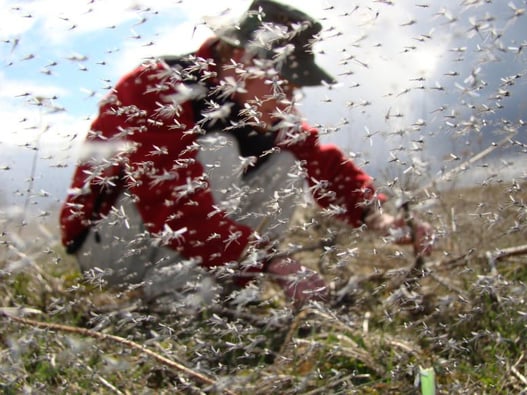Get Rid of Midges in NJ and PA
What are midges?
There are two types of midges that you will encounter in New Jersey and Pennsylvania: biting and non-biting midges. If you live near a body of water, the threat of non-biting midge swarms is present during late spring. They move in massively large groups, covering parts of your home in a blanket of flying pests, and even blinding drivers and anyone trying to go outdoors. Biting midges are also a concern because of their ability to bite and cause allergic reactions.
Non-Biting Midges

Pictured Above: Non-biting midges attracted to a porch light Photo Credit: NC State Extension Publications
Non-biting midges are small (1/8-inch to 1/2-inch long), delicate, mosquito-like, but lack scales on their wings. Adults are humpbacked, brown, black, orange, or gray, lack a long beak (proboscis), and males have very feathery antennae. Some are known as "bloodworms" or "red worms" due to the presence of hemoglobin in the blood. Others have a greenish color. Most live in fresh water while others are found in very moist soil, in wet moss, and under damp bark. Most larvae feed on algae or small aquatic plants.
Occasionally during April, May, and June, homeowners become alarmed by large swarms of gnat-like insects. These non-biting midges are found near lakes, ponds or streams and may "dance" in swarms over the water, inciting fish to jump. Most occur in huge swarms or small compact mating swarms, and a "humming" can be heard over a considerable distance. After sunset, adults become active and fly to night-lights, entering structures through the slightest of openings. Piles of eight to twelve inches of dead midges may accumulate in unwanted places, leaving behind a smell similar to dead fish.
Biting Midges (punkies or no-see-ums)

Pictured Above: biting midges Photo Credit: University of Florida
Biting midges, punkies, or no-see-ums are very tiny (less than 1/4-inch long), slender gnat-like flies. Some have narrow spotted or clear wings. Larvae are tiny, whitish, elongate, or worm-like, and are found in sand, mud, decaying vegetation, and water in tree holes.
Crane flies are also considered midges. To learn more about crane flies, click here.
Where do midges come from?
Midges live near bodies of water such as lakes, marshes, and rivers. If you home is backed up to a lake, the likelihood of midge activity is higher than someone who lives in the city. During peak non-biting midge season, extremely large groups can accumulate in freshly applied paints, hanging onto outdoor laundry, and clustering on screens. This activity can be so intense that it can be difficult to see while driving and unbearable to walk through.Do midges bite?

Pictured Above: midge swarm Photo Credit: University of Wisconsin-Madison
Biting midges suck blood from humans, mammals, reptiles, and other insects. Bites can cause itching and, in sensitive individuals, welts and lesions that can persist for several days. If you are near their breeding grounds, midges can appear in large numbers, resulting in many bites. Midges have not been known to transmit diseases to humans.
How do I get rid of midges?
Houses and buildings with outside lighting will attract large numbers of non-biting midges. Move light away from sensitive areas such as doorways, windows, patios, etc. Avoid the use of unnecessary lights until 45 minutes after sundown since 90% or more of flight activity takes place before that time. Sometimes, eggs are laid on surfaces around lights and on buildings. These egg masses can become unsightly and smear when wet. By replacing a 100-Watt mercury vapor light (ultraviolet energy) with a 50-Watt high-pressure sodium vapor light, midge concentrations are significantly reduced. Lights least attractive to insects are sodium vapor or halogen with pink, yellow or orange tints and dichrom yellow bulbs. Black light traps (bug zappers) will kill midges, but unfortunately often attract more midges into the area than are killed.
How can I prevent midges in the future?
Midges may fly as far as a quarter of a mile from the breeding site such as a lagoon, drainage ditch, standing water, lake or pond. They can also develop in and around buildings in well-watered soils and occasionally in standing water from air-conditioning units on building roofs. Clean up or remove stagnant, polluted water accumulating in bird baths, clogged rain gutters, water-holding tree stumps, flower pots, and old tires.
Because midges aren't the strongest fliers, using porch fans at high speeds can temporarily deter them from descending upon your patio in the summer. Another way to prevent midges is to install screening around the outdoor area that you will be spending time in. Keep in mind, midges are very small so the screening needs to have extra small gaps. Personal flying pest or mosquito repellents containing DEET can help prevent midge bites when applied correctly, before spending time outdoors. Unfortunately, midges cannot
How can Cooper Pest Solutions help?
Midge infestations require an inspection by one of our flying insect specialists. This inspection aims at finding the breeding source of the infestation. Once our specialist locates the breeding source, they provide recommendations for how to fix or remove it. Midge inspections are charged hourly at a rate of $125 per hour with a minimum of one hour. Please call our office at 1-800-949-2667 or fill out the contact form on this page to schedule an inspection of your home.

